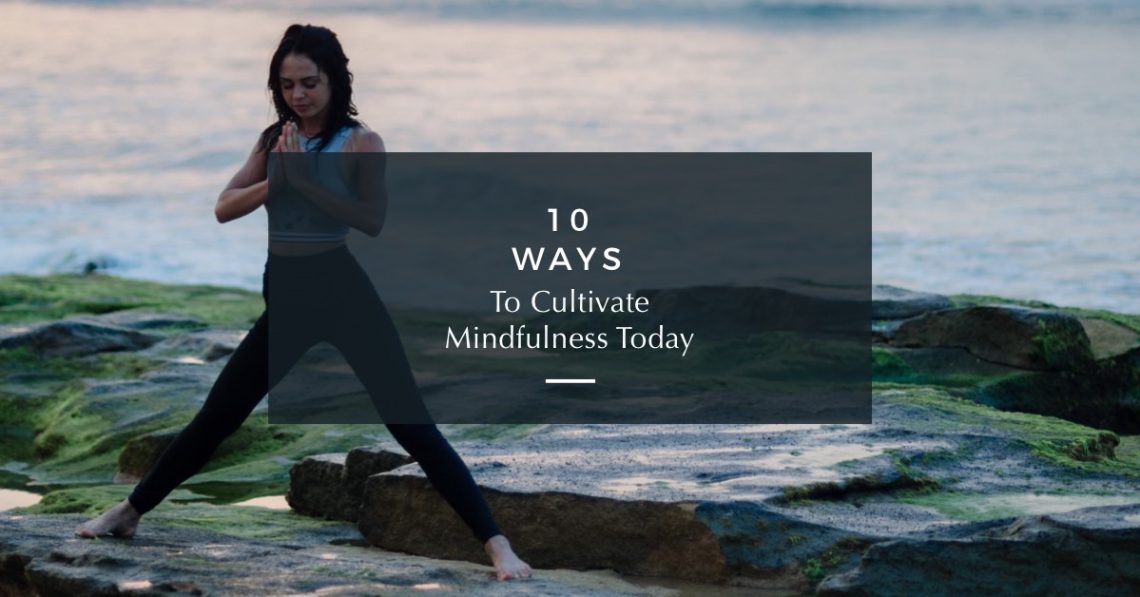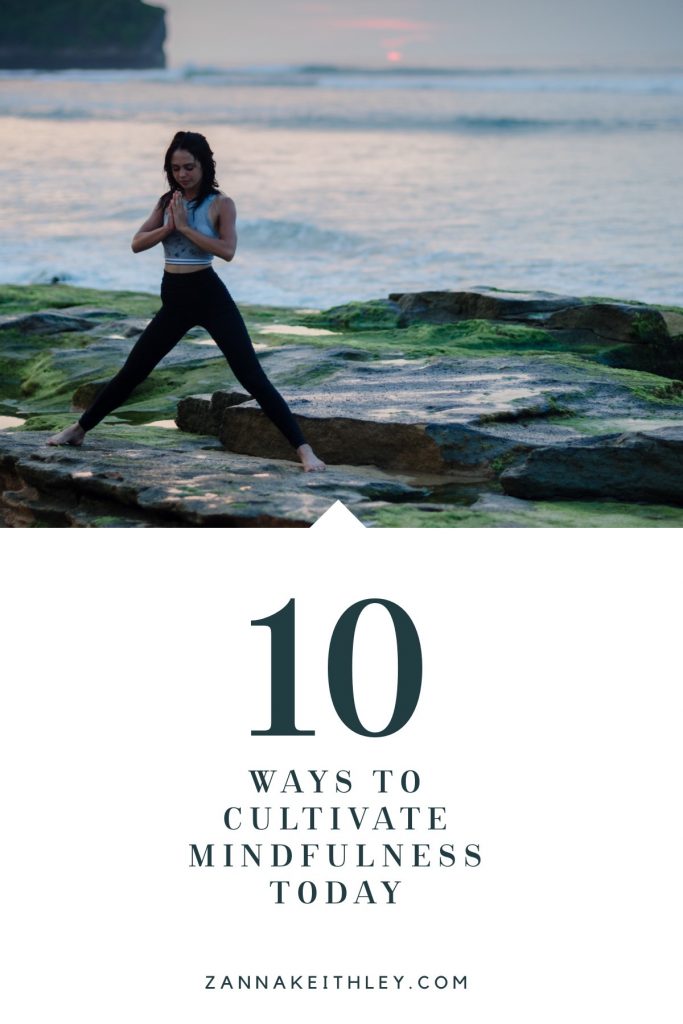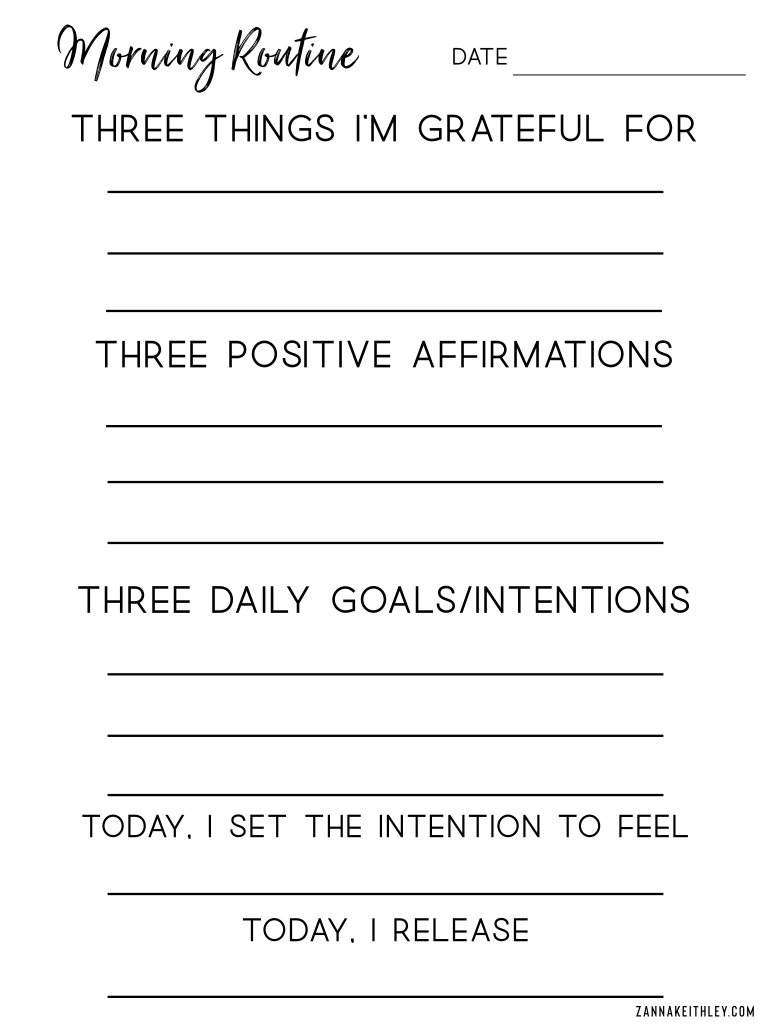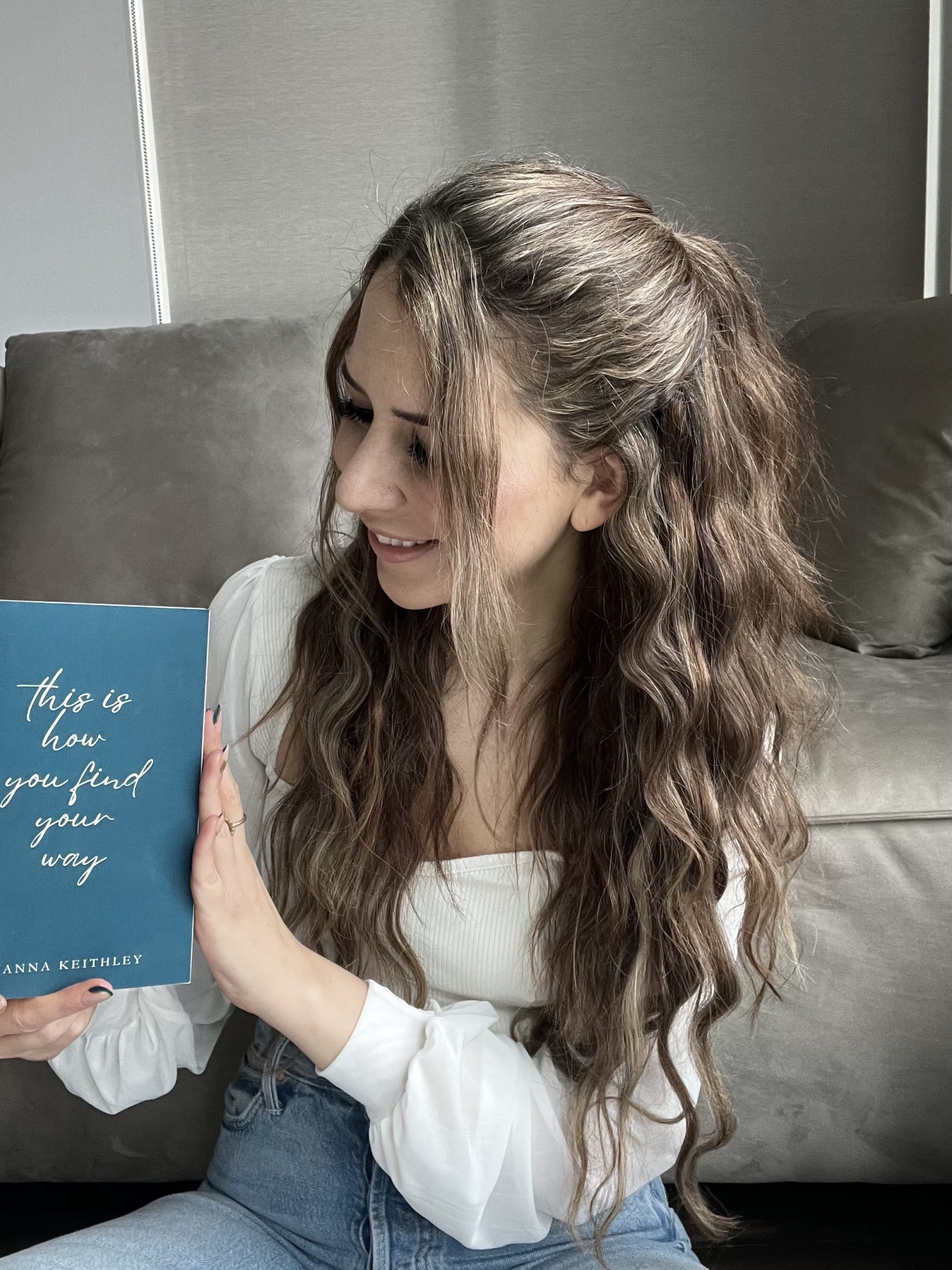
10 Ways to Cultivate Mindfulness Today
As a follow-up to my blog post, What is Mindfulness? Plus 15 Powerful Mindfulness Quotes, I’m giving you 10 effective ways to cultivate mindfulness as you become more conscious of your thoughts and start living in the present moment. The best part? Most of these are simple practices you can start doing at home today.

What is Mindfulness?
In my recent blog post, What is Mindfulness? Plus 15 Powerful Mindfulness Quotes, I gave you my definition of mindfulness, the three components of mindfulness, and a list of powerful quotes from prominent thought leaders on the practice of mindfulness.
To recap, I define mindfulness as non-judgmental, conscious awareness in the present moment.
One of my favorite definitions comes from Jon Kabat-Zinn, the creator of the Stress Reduction Clinic and the Center for Mindfulness in Medicine, Health Care, and Society at the University of Massachusetts Medical School:
“Mindfulness is awareness that arises through paying attention, on purpose, in the present moment, non-judgmentally.”
When we think about mindfulness, it’s likely that the next word that comes to mind is meditation. And while I think meditation has been my most powerful tool in helping me to cultivate mindfulness, you absolutely do not have to meditate in order to live a mindful life.
In fact, anyone can begin a mindfulness practice today, no meditation required. And while you may feel like you’re too busy to start a new mindfulness practice, many of the methods on this list take almost no time at all – just a couple seconds of your conscious thoughts in the present moment.
Below, I’ve written about 10 ways to cultivate mindfulness today. While you definitely don’t have to do all the items on this list, I encourage you to try out as many as possible to see what works for you. To help you out, I listed these in order of practices that take the least amount of time to ones that take the most.
And if you have any questions, don’t forget to post them in the comments below!
Method #1: Phone Notifications/Reminders
The irony isn’t lost on me here. While most of us would say that a little less time on our phones is one of the best ways to cultivate mindfulness, I’m starting out by telling you to spend more time on your phone.
But let me backtrack.
I’m not actually saying to spend more time on your phone; I just think that instead of always focusing on the bad things associated with cell phones, we should focus our attention on the good services they provide.
And one of my favorite ways to use our cell phones for good is to set up positive and uplifting notification reminders that pop up during the day to remind you that you’re doing a great job, that you’re worthy, that you’re capable of doing incredible things – whatever you know you’ll need to hear when you’re in the middle of a chaotic workday.
So how can we use these notifications as a way to cultivate mindfulness?
By setting up reminders to pause in the middle of our day and breathe. These don’t have to be anything dramatic. One of my favorite gentle reminders?
“Breathe.”
Some other reminders you can set up to help you cultivate mindfulness:
- Pause. Breathe. Be.
- Notice your surroundings.
- Pause and look around you. Then, look within.
- Inhale. Exhale.
- Where is your mind right now?
- Where are your thoughts right now?
- Come back to this present moment. Don’t judge. Just be.
At most, these notifications may take a minute or two to set up, but once you have them stored in your phone, you can set them to pop up for you as many times as you want during your day.
Method #2: Post-It Notes
Essentially, post-it notes work in the same way as reminders on your phone, but if you don’t like to look at your phone during the day, this might be a less intrusive method for you. (Or, if you don’t want to choose, do both!)
You can use some of the same reminders I wrote above on your post-its. (Or index cards, scrap pieces of paper, napkins . . . anything you want to write on.) Then, place them in spots you know you’ll see them during the day.
Some suggestions for placement:
- Near your work station
- On your bathroom mirror
- In your wallet
- Near your phone charging station
- Next to the coffee pot
- In your pocket
- Next to the car radio or drink holders
The most important thing with the post-it method is not to get so used to them being there that you ignore them. Set the intention to read the post-its when you see them. Switching out the message weekly and/or using bright colors might help with this.
Method #3: Set Daily Intentions
One way to cultivate mindfulness is to set the intention to practice mindfulness throughout the day. I’m big on having a morning routine (more on that below!), but if you don’t have time for a longer routine, spend just one to two minutes every morning setting a purposeful intention.
Now, this intention doesn’t have to just be, “I will practice mindfulness today.“
To mix it up, you can focus on some of the different components of mindfulness each day.
Here are some examples of daily mindfulness intentions:
- Today, I set the intention to practice non-judgment.
- I will step back from my work once an hour to take three deep breaths.
- Today, I pledge to live in the present moment. When I find my mind wandering to the past or future, I’ll gently bring it back to right now.
- I will observe my internal world with objective awareness.
- I will observe my external world with objective awareness.
Again, the key here is to come back to your intention throughout the day. As you start this practice, phone reminders or post-it notes might benefit you. Or, if you have a whiteboard in or near your work space, you can simply write on it, “Remember your intention.” Let those words bring you back to the present moment.
Method #4: Follow Social Media Accounts that Teach, Discuss, and Encourage Mindfulness
Yes, I know.
Social media is just as bad as phones.
But again, I think we can use social media in this instance for good, not evil.
Do you have Instagram? Twitter? Facebook? Do you find yourself checking your social media once, twice, three times or more a day?
While social media detoxes are good for all of us every once in a while, we don’t have to cancel all of our accounts in order to practice mindfulness.
There are a lot of really amazing people on social media talking about mindfulness every day. These people are using their platform to teach and share their knowledge and experiences.
So let’s let them teach us.
We often open our social media apps on autopilot, not thinking twice about what we’re doing, so a powerful practice is to be mindful every time we open up one of our social media accounts. Notice (with objective awareness . . . no judgment) when you’re clicking that little square on your phone. Are you bored? Sad? Avoiding bad or negative feelings? Again, don’t judge yourself here. Just notice.
Then, when you have that account open, add accounts to your feed that talk about mindfulness. This doesn’t mean you have to unfollow your friends or favorite celebrities. Just find a few accounts that speak to you (you can search the hashtag #mindfulness and go through some of the popular pins to get started), and follow them. Every time you open your app, make sure you read through their images and captions.*
I know this one might sound silly or stupid to some, but I think there’s power in seeing examples, thoughts, ideas, and definitions about mindfulness every day.
My Mini-Disclaimer
*To be clear, I very much believe in listening to what other people have to say about a subject and then forming your own opinions and truth. If you follow a mindfulness blogger who says something that doesn’t feel right to you, question it. You don’t have to blindly accept anything that anybody (including me) tells you, especially if it doesn’t feel right.
Method #5: Breathing Exercises
Not sure if you want to start a meditation practice? Or you already do meditate, but you want to enhance your practice? Breathing exercises are a perfect tool to increase mindfulness, and the best part is you can do them anytime and anywhere.
While there are many variations of breathing exercises, your practice can be simple and straightforward.
For example, breathing from your belly, inhale for four seconds. Hold your breath at the top for another four seconds. Then exhale for four seconds. If you’re comfortable, you can try a variation of this, where you inhale for four seconds, hold your breath at the top for seven seconds, then exhale for eight seconds. You can breathe through your nose or mouth, whatever is most comfortable for you.
Even if all you can do is take a couple seconds for a few slow, conscious inhales and exhales, that’s okay.
The key to using breathing exercises to cultivate mindfulness is to focus on your breathing, grounding yourself in this present moment. And when we are continually able to return to the present moment, we allow mindfulness into our experience.
Method #6: Lean Into Frustrating Moments
This one is tough, but if you stick with it, it can be the most worthwhile.
It’s likely that nearly every day, you encounter experiences that cause you to feel annoyed, frustrated, and maybe even a little angry. Your heart rate increases. You feel a tightness in your chest. Or maybe it feels more like heat pulsating through your veins. Whatever it is, it’s uncomfortable and you don’t like it very much.
To cultivate mindfulness, don’t suppress or pretend these moments don’t exist.
Instead, lean in.
I’m not saying, “Let yourself get so angry and upset that the negative energy overcomes your entire body.”
What I’m saying is this: get curious.
To start, set an intention to recognize your moments of discomfort and/or frustration throughout the day. If you already know that your morning commute is going to make you want to smack your head against the steering wheel, decide to approach the commute a little differently today.
Now, you’re stuck in traffic. The cars aren’t moving. Or maybe someone cut you off. To be clear, you definitely don’t have to like these moments. Allow yourself to feel whatever emotions are rising within you.
And then, simply notice.
Now get curious. Ask yourself questions: Why am I frustrated right now? Why does this experience cause me to feel this way? What do I see in my surroundings right now? What would I change if I could?
Become an objective observe of yourself. That means no judgment. Just notice, probe, observe. Let yourself stay grounded in this present moment.
Now, see if you can do the same thing tomorrow. And the day after that. And then see if you might be able to have this same mindset when an unexpected frustration pops up during your day.
It won’t happen overnight, but if you do this consistently day after day, with time, you’ll see a shift in your mindset and how you view your present experience.
Method #7: Get Outdoors
I can’t quantify how much time this will take during your day. It may take seconds. Maybe minutes. Maybe an hour or more. But if you can make time for 15 minutes to go outside, you’ll experience huge benefits to your mindfulness.
Let’s say you have a 15-minute break during work, and you choose to step outside and take a walk during that time. Or maybe you decide to take a short walk outdoors after dinner. Whenever you can fit in this time, set the intention to stay in the present moment as you walk.
Now, as you’re walking, notice your surroundings. Take note of what you see and hear. How does the air feel on your skin? What sensations do you feel in your body? Is there tension in your muscles? Tightness in your chest? How do your feet feel in your shoes, walking against the ground?
Whatever your answers are, don’t judge. There is no right or wrong, no good or bad. And when you realize your mind has drifted away from the present moment, gently bring it back to right now.
The goal here isn’t to keep your mind from drifting.
The goal is to notice when your mind has strayed and to gently return it back to the present, over and over again.
If walking isn’t your thing, you can also perform this mindfulness exercise when gardening, mowing the lawn, or raking leaves. If the weather permits, you might also choose to do it while stretching outside.
And finally, whatever you decide to do, remember to breathe. Anytime your mind strays, remember that you can always return to the breath.
Method #8: Establish a Morning Routine
Depending on your available time, these last three practices can take anywhere from five minutes to an hour. (And you might also be able to combine them with other practices on this list.)
I’m a big proponent of having a morning routine that isn’t just about hurrying to rush out the door. Personally, I like to journal for 30 minutes first thing after I wake up. I do this when the house is quiet and it’s still dark outside. For me, this is my time to write, create, reflect, and uncover my own feelings, ideas, and thoughts. I also usually work out in the morning, either by running, HIIT exercises, yoga, or light stretching on recovery days.
So how exactly does any of this cultivate mindfulness?
A couple ways.
For one, you might choose to add specific mindfulness practices to your morning routine. You might choose mindful journaling, which entails writing about your thoughts, surroundings, and present experience with objective awareness. You can also add other practices on this list, like daily intention setting and breathwork.
I believe there’s also something powerful about having an intentional and conscious morning routine, no matter what it entails. It means that instead of just unconsciously going through the motions, you’re choosing how you greet the day. And when you start the day by consciously choosing your experiences, you’re more likely to continue this practice throughout the day.
Morning Routine Template
Below is the morning routine template I created for my post, How to Design a Morning Routine for Manifestation. If you don’t have time for journaling, utilizing a template such as this one is a powerful way to set your intentions for the day.

Possible Components of Your Morning Routine
- Journaling
- Meditation
- Yoga
- Intention Setting
- Daily Affirmations
- Breathwork
- Reading
- Exercise
- Morning Walk
- Gratitude Practice
Method #9: Meditation
If you’re looking to start a mindfulness practice, it’s hard to find anything that will serve you better than meditation.
First, let’s dig into some myths about meditation.
Meditation is not “clearing your mind of all thoughts.”
And “not thinking” is not the goal of meditation.
Rather, in meditation – mindfulness meditation, specifically – one simply breathes in the present moment, notices when they have a thought with objective awareness, and gently releases it, returning to the present moment.
For instance, imagine you’re laying on the ground looking up at a perfectly blue sky, and a cloud passes above you. “Look, there’s a cloud,” you think. Then it floats out of your vision, and you let it go without attachment.
These clouds are your thoughts. Notice. Release. Come back to the present, over and over again.
If you’ve never meditated before, starting a meditation practice may seem overwhelming at first. To help, I’ve created 7 Meditation Practices for Beginners, which gives you suggestions for how to start as well as links to guided meditations using the Insight Timer app. (No affiliation.)
Just know that even if someone on a podcast says they meditate for two hours a day, or an Instagram influencer swears by meditating for twenty minutes twice a day, you don’t have to start big. When I started meditating, I pledged just ten minutes a day. Sometimes, five. And even now, I often meditate for no more than ten to fifteen minutes.
You can definitely cultivate mindfulness without meditation. The walking exercise I described in the “Get Outdoors” section is a great way to start. But I believe meditation has been my greatest teacher in cultivating mindfulness. If you’re open to it, pledge to meditate for ten minutes a day, ten days in a row. Start small, then see how you feel after that.
Method #10: Yoga
Yoga is another powerful practice that may take ten minutes, an hour, or somewhere in-between. If you’ve never tried yoga before, this one might be even more intimidating than meditation. So let’s make it a little less intimidating by talking about why yoga cultivates mindfulness and how to gently step into a new yoga practice.
First, like we did with meditation, let’s debunk a myth about yoga:
Yoga isn’t about getting into a pose and holding it as long as possible until you can no longer stand the pain.
The beauty of yoga (in my experience, at least) is in the flow: the gentle awareness of the energy flowing through my body. Yoga is when my mind and body become one, and I simply exist in this present moment. The greatest lesson I’ve learned from yoga isn’t to become more flexible; it’s to become one with my breath.
Yoga cultivates mindfulness because it allows us to be in this present moment, at one with our breath, simply noticing the sensations and feelings in our body with non-judgmental awareness.
If starting a yoga practice seems intimidating, YouTube might become your new best friend. There are thousands of videos online dedicated to beginner’s yoga. If you’re not sure where to start, I highly recommend Yoga With Adriene’s Foundations of Yoga series. This series is comprised of 45 separate five to twenty-five minute videos, each dedicated to helping you explore a different yoga pose. I love these because you can take your time with each pose and go at your own pace.
If you want to learn a little more about yoga and mindfulness, here and here are a couple articles that dive a little deeper into the connection between your body and your mind.
And there you have it: ten ways to cultivate mindfulness today. Remember that you don’t have to include all ten practices into your life today. Start small. Choose a few that feel right to you. And if one of those methods doesn’t click, choose again. And remember that every moment in our lives provides us with an opportunity to practice mindfulness. Even right now. Notice the thoughts, sounds, sensations, and feeling of the present moment. No judgments. Just observe.
Other Posts You Might Like
- 10 Science-Backed Health Benefits of Meditation
- A Beginner’s Guide to Understanding and Unblocking Your Chakras
- 25 Epic Morning Affirmations to Create a Beautiful Day


Zanna Keithley is an author, poet, and social media content creator who writes short prose dedicated to inspiring readers to follow their dreams, trust their intuition, and create beautiful and fulfilling lives. You can find her original writing on Instagram @zannakeithley.





